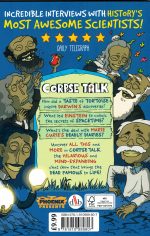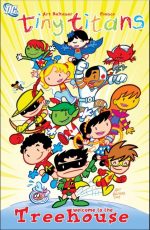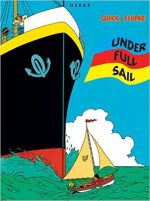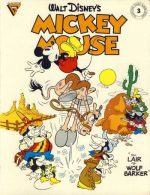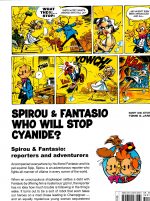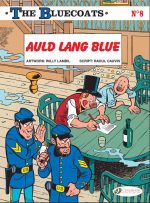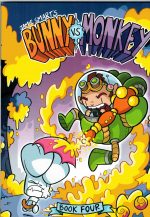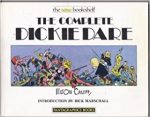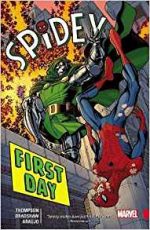
By Robbie Thompson, Nick Bradshaw, André Lima Araújo & various (Marvel)
ISBN: 978-0-7851-9675-4
Since its earliest days the company now known as Marvel has always courted the youngest comicbook consumers. Whether through animated tie-ins and licensed properties such as Terrytoons Comics, Mighty Mouse, Duckula, assorted Hanna-Barbera and Disney licenses and a myriad of others, or original characters such as Tessie the Typist, Millie the Model, Homer the Happy Ghost and Calvin, the House of Ideas has always understood the necessity of cultivating the next generation of readers.
These days, however, kids’ interest titles are on the wane and, with the Marvel Universe’s characters all over screens large and small, the company usually prefers to create child-friendly versions of its own proprietary pantheon, making that eventual hoped-for transition to more mature comics as painless as possible.
In the 1980s Marvel published an entire line of kiddie titles through its Star Comics line and in 2003 the company created a Marvel Age line which updated and retold classic original tales by Stan Lee, Jack Kirby and Steve Ditko and mixed it in with the remnants of its manga-inspired Tsunami imprint: again all intended for a younger readership.
The experiment was tweaked in 2005, becoming the Marvel Adventures line, with titles reflecting the most popular characters and whatever was on TV screens at the time.
In 2012 these were superseded by specific comicbook titles tied to Disney XD TV shows designated as “Marvel Universe cartoonsâ€.
Today’s featured item – Spidey: First Day – is a horse of a different colour: similar but different…
Rather than simply crafting a wallcrawler for younger sensibilities, this iteration – presumably sparked by the teenaged, light-adventure version seen in the Spider-Man: Homecoming movie – innovates and modernizes by looking back and succeeds in recapturing a sense of the madcap gaiety that counterbalanced the action and pathos of the earliest Lee/Ditko stories. This series is all about thrills and fun…
Scripted throughout by Robbie Thompson and re-presenting Spidey #1-6 (originally released from February to July 2016), the non-stop, youngster-appropriate mayhem commences with a fresh introduction to ‘The Amazing Spider-Man’, illustrated by Nick Bradshaw and colourists Jim Campbell & Rachelle Rosenberg
Firmly set in The Now, our hero is still (or rather once again) a callow schoolboy, fighting crime and making enemies between classes. He’s also a crimefighting sensation of the internet and social media when he puts on his blue-&-red duds. As ever news magnate J. Jonah Jameson is there to vilify the webslinger at every opportunity…
Sadly, thanks to the kid’s double life, Peter Parker‘s grades – except for science and maths – are tanking now, and the secret superhero is forced to accept Popular Girl Gwen Stacy as a much-needed history tutor.
Not only is she the hottest girl in school but she also decks Flash Thompson with one punch after the jocks starts bullying “Puny†Parker again…
Things really kick off later, on a field trip to techno-industrial wonderland Oscorp, when a madman calling himself Doctor Octopus busts in and the neophyte Spider-Man is compelled to intervene and drive the maniac away.
That’s when uber-creepy Norman Osborn introduces himself to Peter, predicting big things for Peter…
The really smart trick in this series is that battles with other supervillains such as Kraven the Hunter and Mysterio are backdrop: referenced simply as having occurred in other moments, allowing Peter Parker’s life and character room to develop, with only new battles dictating how certain villainous players have evolved from standard Spider-Man mythology…
A month later Peter is still coming to terms with his double life when ‘Enter the Sandman’ finds him battling a grittily shapeshifting bank robber, after which New York is overrun by tiny reptiles as old ally Dr. Curt Connors is once again tragically transformed into the ravenous ravening Lizard…
In Spidey #4 André Lima Araújo assumes the art duties with ‘Doomsday Off!’ as Peter stumbles into an art robbery. He might even have stopped the thief… if the bad guy hadn’t been Doctor Doom! Tracking down the ultimate villain does no good and Spidey is once again soundly thrashed, but after the Amazing Arachnid gets a pep talk from a little kid, he tries again and achieves a partial victory…
‘Dead End’ (with Java Tartaglia joining the colouring squad) sees the first inconclusive confrontation with a major nut job called the Green Goblin after which the ebullient effervescent escapades conclude with a first team-up in ‘Making the Grade’, as the mysterious Spider-Man intervenes when flying felon The Vulture burgles Stark Industries.
The Invincible Iron Man shows up but naturally gets the wrong idea – as does SHIELD agent Phil Coulson – before the situation is straightened out. One crisis over and feeling cocky, the very junior hero – smitten with Gwen Stacy – even asks the Armoured Avenger for dating tips but that doesn’t go so well…
Featuring a covers and variants gallery by Bradshaw, Lima Araújo, Skottie Young, Humbert Ramos & Edgar Delgado, Oliver Coipel, Julian Totino Tedesco and Gyimah Gariba, this a sublimely refreshing reinterpretation of an evergreen heroic icon offering an intriguing and certainly more culturally accessible means of introducing character and concepts to kids born two and three generations or more away from those far-distant 1960s originating events. These Spidey super-stories are outrageously enjoyable yarns, and well worth seeking out.
© 2016 Marvel Characters, Inc. All rights reserved.

